- Aditya went for an exciting short trip (includes trek) to Jhiji village (height app 9,000 feet) in Chamoli’s Nijmola Valley. Area is scenic and village a base for more Treks. Due to excellent Net Connectivity, for 3 days it was work from home.
I am a Garhwali (Pahadi from Uttarakhand) by birth and have spent fair share of
my time in the hills, yet this experience was distinct and arduous. After
walking for over two hours and climbing a steep ascent, my body gave up. I was
also carrying a rucksack on my shoulders (always hire a porter for luggage).
But had to reach Jhiji village where I was a guest so drew on reserve energy.
Also, in my subconscious mind, I knew there was no turning back.
Finally, after walking for over four kilometers (2.5 miles), I made it to the village i.e. almost 480 km from Delhi where I live. Though it was pretty dark I finally spotted hamlets and was relieved to find that they were connected to an electricity grid. The mobile internet signals were live again. Most importantly, I would finally get to rest. It was the second day of a week's trip that began in Delhi. I was to spend the next five days in village Jhiji at Nijmola Valley.
 Google Earth
Location Map.
Google Earth
Location Map.
Where
is Nijmola Valley
At an average
altitude of 8500 feet, Nijmola valley is located in the Dasholi block of
Chamoli district in the state of Uttarakhand. The nearest hospital or a police
station is about two hours away. Though it looks barren at first glance, the
valley is home to unique flora and fauna (mainly visible post-spring season).
Since I visited on 25th December 2021, it was nothing to write home about.
That said, it doesn’t mean it is dry in the winters. The Himalayan River Dhauli Ganga (a tributary of the Holy Ganga) which rises in the border regions of India and Tibet, supports the growth of chir, pine trees around the region. Geographically, Nijmola is surrounded by Gopeshwar and Pokhari Block in the west, Ghat and Karnaprayag Block in the south.
Since public transport is limited post Chamoli, it is better to hire a vehicle. Most people visit this valley to reach famous picturesque treks like Kuari Pass and Saptkund. The former is also known as Lord Curzon (a British Viceroy of India) trail. It offers a view of some of India’s most celebrated peaks i.e. Mt Nanda Devi (25,673 feet) and Mt. Dronagiri (23,182 feet). The Saptkund means a group of seven high-altitude lakes perched that are at a height of 16,000 feet.
 Glacial lake Shweta glacier. Mt. Satopanth is top of pic. Pic by Venkat Gandikota.
Glacial lake Shweta glacier. Mt. Satopanth is top of pic. Pic by Venkat Gandikota.
Journey
to Jhiji Village
There are no
motorable roads to the village. To reach one must walk for about 4 kilometers
which includes an arduous steep ascent, or hire mules. But the good thing is that
work for a road till the village is in progress and engineers on site say the
road should be ready within the next five years.
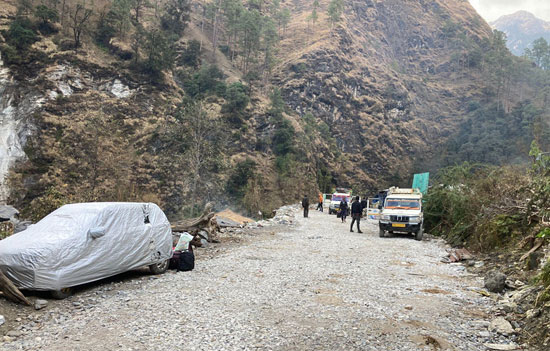 Motorable road ends here.
Motorable road ends here.
If you can understand and speak Hindi, you wouldn’t have a problem conversing with locals. Although, the local language spoken here is a pahadi dialect, i.e., Garhwali.
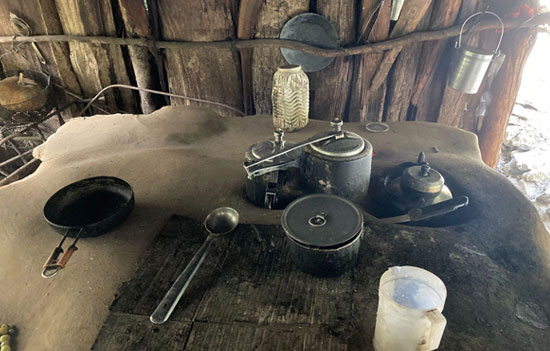 A small tea shop on the way.
A small tea shop on the way.
When I stepped out of the car, the first thing I noticed was it was much colder than places enroute starting Delhi. There were a few small shops as not many tourists visit the area and the road is virtually a dead end. Within a few minutes of our arrival, we were greeted by our hosts. The word “We” includes my friend, Bijendra Singh Negi, his wife, and her father. This village is actually the native place of his wife.
 A selfie clicked along the way.
A selfie clicked along the way.
It was the
beginning of the trip of a lifetime. We were joined later by other people from
the village who were sweet enough to help us with the luggage. Some villagers visit
the central market at Chamoli twice or thrice a week to buy goods to sell at
Nijmola-a small business or buy essentials unavailable locally.
As said earlier it
was not an easy trek. We reached at 8pm. The welcome was warm. On arrival, I
washed up and headed for dinner. I was tempted with delicious local organic
vegetables cooked over wood.
 Wheat bread served with pahadi bitter gourd
Wheat bread served with pahadi bitter gourd
They had also cooked Chicken, but since I don’t consume meat did not eat. After a delightful meal, we had pleasant conversations and went to sleep, were exhausted.
Waking Up to Beautiful and Pleasant Weather
I woke up to the
sound of children playing in the courtyard. The family I stayed with have four
kids-two of them attended the primary school nearby and were now enjoying
winter holidays.
I was still tired.
Moreover, my friend and I had not slept the previous night. Temperatures were
sub-zero. The room being made of brick and mortar it was not suited for such
weather and quilts inadequate. But we did not let this dampen our spirits.
A few minutes later my friend's brother-in-law, Heera Negi, house owner and father of the four kids, brought us some fresh milk tea. It was warm, bubbly, and delicious. After finishing that tea, we went outside to see sun rising from the peak above.
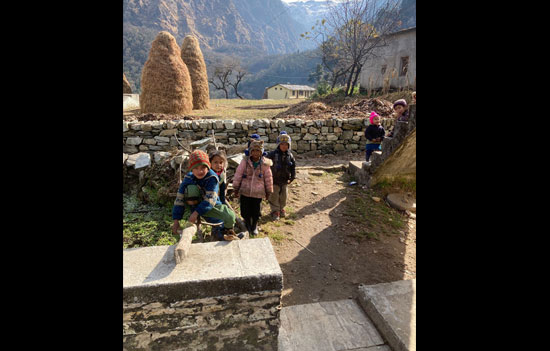 Village kids playing in the courtyard, around sunrise
Village kids playing in the courtyard, around sunrise
Since it was a
Sunday, we decided to visit a Bugyal
(Meadow) situated above the village. It would be a challenging five-kilometer
trek, but we were determined. So, without wasting any time, we had a bath and breakfast.
We went in a group of four; one of us was Debendra Singh Negi, a trekking
expert and hiker who helps people reach well-known and arduous destinations.
The list includes Roopkund, Saptkund, Kuari Pass, and Mount Kamet. To know more
about that experience, please see my Instagram post. We made it to the top because of his expertise. He guided, motivated, and helped us reach the Bugyal.
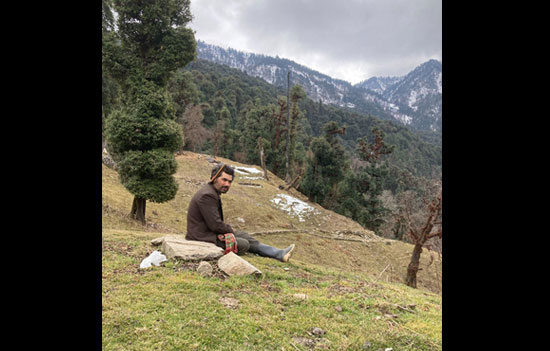 Debendra Singh in the meadow
Debendra Singh in the meadow
We reached our destination at 1 pm. The place was surrounded by massive peaks endowed with alpine trees like rhododendrons, Chir, etc. We could see Altocumulus clouds moving below the tall mountains and the endangered state bird “Monal” chirping somewhere in the dense forest nearby. We decided to stop by near a waterfall, which was almost frozen. The meadow was a tranquil site, far removed from the main roads of present-day habitation. Heera and Debendra quickly lit fire on small wood pieces to cook noodles and make some Chai. On the other hand pal Bijendra and I were shivering, amazed at the beauty of this location, and busy clicking pictures and videos.
Once we were done
with lunch, we began descent towards the village and reached at 6 pm. It
started to snow around 3 and was snowing thereafter. We walked on a slippery
slope, which was more difficult than going up. We were lucky to be guided by two
villagers that included trekking expert Debendra Negi. Due to their support we completed the walk
through wet, uneven boulders and rugged paths.
This just proved how tough pahadi people are. Actually, they have grown up walking up and down the hills, so body gets used to it. What we in metropolitan cities take for granted is a luxury to many, esp. for whom the nearest hospital is 2.5 hours away and the motorable road 4 kms away. Yet, these people go about their lives effortlessly, calmly and deal with unforeseen circumstances with resilience. The most significant impact of it was seen post COVID19. The virus that rattled the global economy also affected the limited tourism business in this area. The homestays lay vacant. It’s been two years since local trekkers took visitors to the famous nearby expeditions like Kuari Pass and Saptkund.
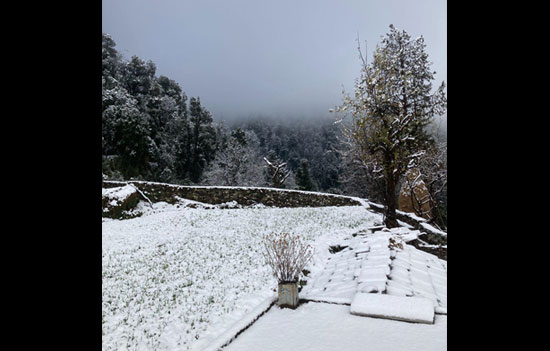 View from terrace of our room.
View from terrace of our room.
The
Next Three Days
We decided to relax for the next few days. Also, it snowed heavily in the next two days so going out wasn’t recommended. Since I had carried my laptop and net connectivity was good (internet speed much higher than what I get in Delhi, thanks to JIO), I did office work. Never had
I dreamt of working from a village home surrounded by snow-clad mountains and
at a height of app. 9,000 feet.
Do you know that
the people of Jhiji grow potatoes, Kidney beans, Mandua (Finger Millet), and
other nutritious fruits and vegetables? Most families have cows so unless you
are lactose intolerant you may get to savor fresh butter, milk, and ghee
(clarified butter). To this add scenic views, company of some fantastic, humble
people, excellent internet and stable electricity connection. What else can one
ask for?
 Local
vegetables and curry made up of yogurt, served with rice.
Local
vegetables and curry made up of yogurt, served with rice.
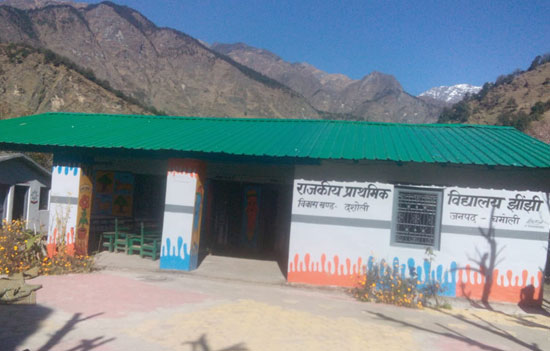 Primary School in the village. Pic by Heera Negi.
Primary School in the village. Pic by Heera Negi.
Do
not be tempted by the Scenic Beauty alone
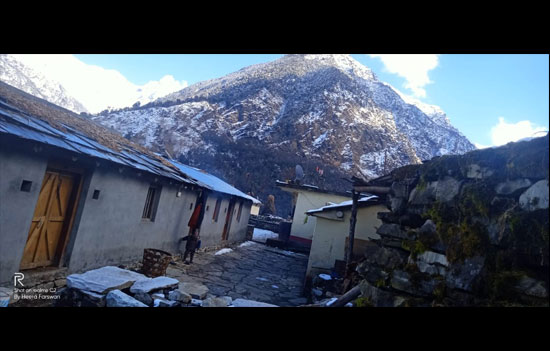 We stayed in structure on left.
We stayed in structure on left.
I am a pahadi by
birth and have spent my fair share of time in the hills, so I can endure cold
weather but staying here, especially when it snows, can be fatal for many. The
roads get blocked, and you might have to stay indoors for weeks if the
situation worsens. One must wear warm clothes, carry extra pair of socks, have
head and ears covered at all times. Otherwise, visit the place in the summers
once the spring season ends (July-August-September). There will be much more to
see, and you would not spend your time staying inside the quilt or lighting
firewood.
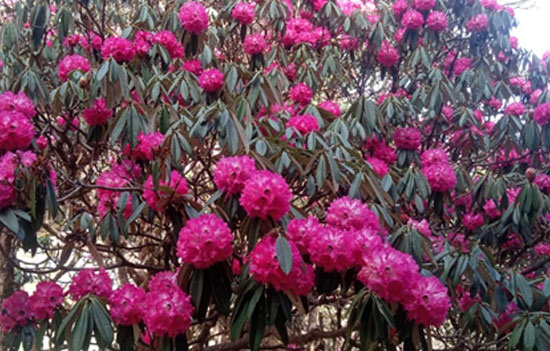 Flowers
blooming post-spring. Pic by Heera Negi.
Flowers
blooming post-spring. Pic by Heera Negi.
For Home Stay (being made as on date of writing) and trek to Kuari Pass and Saptkund etc contact Heera Negi at 91 78199 65125 in village or Bijendra Singh Negi who lives in Rudraprayag 91 99174 26396. Unless stated all pictures by author.
To visit author website
Reference
1. About
Nijmula Village
To read all
articles by author